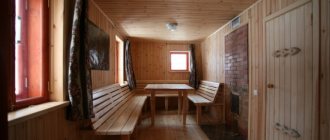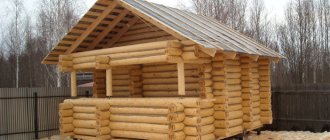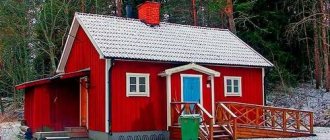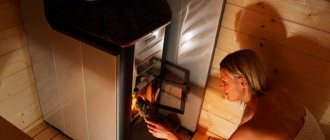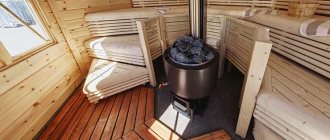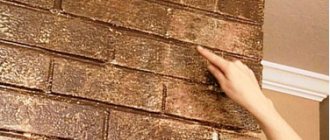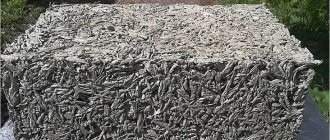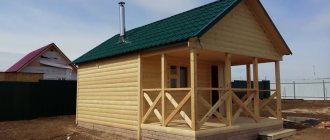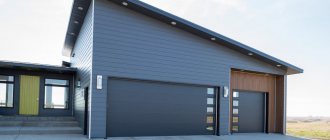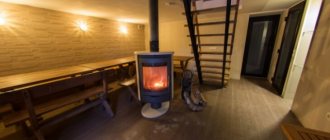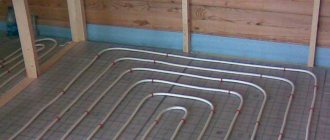312
Regular visits to the sauna are a great way to relax, support your immune system and improve your overall health. That is why many of us dream of building a compact bathhouse complex on our own plot. And the “heart” of the wooden structure is the stove, the performance characteristics of which determine the quality of the steam in the steam room and the effectiveness of the bath procedure. For decades now, the Troika sauna stove has held the palm among similar designs. What is the secret of its popularity?
Troika is one of the most reliable oven equipment on the market
general description
Troika units have a simple appearance at first glance, but they have high power, and also allow you to additionally cover the surface with brick. The latter circumstance allows the unit to fit into almost any interior. Another advantage of such stoves is that they are manufactured at a factory in Russia, this indicates their adaptability to harsh climates, which cannot be said about some foreign-made heating devices. Most often, in the manufacturing process of the described furnaces, low-alloy steel is used, which is a feature of Troika products.
Positive and negative feedback
If you are interested in Troika stoves, then you should read the reviews in more detail, from them you can understand that in winter these models take about 3 hours to heat up, in summer this time will be reduced. As buyers emphasize, a large amount of fuel is not required for bathing procedures, while the heat is retained in the room for about 10 hours during operation of the device. This equipment is inexpensive, but it does the job for two.
Users also note some disadvantages, including the enormous weight, which sometimes reaches 380 kg. This sometimes leads to difficulties during transportation and installation. Thus, in order to lift the unit, the strength of 4 people will be required. Some owners of country houses and country houses also note that they do not really like the need to cover the front surface of the stove with bricks. But the manufacturer counted on exactly this when designing the products. Finally, the walls are thick, which results in later heat transfer. In this regard, these designs cannot be compared with bare thin-walled products that are common today.
Strengths and weaknesses of the Troika stove
There are many positive aspects when using this device. Rapid heating of the unit is possible only in the summer; in winter, you will need to spend up to three hours of your time to properly heat the bathhouse. In order for the steam room to function all night, you will need a minimum of firewood. In addition, satisfied users claim that this inexpensive device is ready to work with a vengeance.
With all the advantages, the Troika stove also has certain disadvantages. Due to its rather heavy weight, which only four physically developed men can handle, problems arise with transporting the device. When making an inconspicuous-looking stove, manufacturers hoped that it could be decorated with brickwork.
For the person who purchased such a unit, there will still be additional costs associated with the purchase of material and hiring a specialist. In addition, having rather thick walls, the Troika stove slowly releases heat, which cannot be said about thinner-walled metal sauna devices.
Feedback on design features
Troika stoves have certain characteristics; a distinctive feature of the model range is the thick walls of the firebox. The top element is 10 mm thick, while the side walls are 8 mm thick. Thanks to the use of low-alloy steel in the production process, the device has a long service life. Users really like that the fuel channel is of a remote type, which is why the firebox can be taken out of the dressing room. In this case, the thickness of the walls will not play any role.
If you were looking at Troika stoves and thought that some designs from other manufacturers are very limited in the volume of loaded stones, then you should know that this has nothing to do with these models. The described equipment may involve heating stones whose mass reaches 250 kilograms. For comparison, in models from other manufacturers this figure varies from 50 to 80 kilograms.
About Us
To obtain good quality steam, you need a stove capable of heating a sufficiently large volume of stones (in our stoves the weight of the stones can reach 250 kg or more ). It is not easy to construct such a stove. It should not take up much space in the steam room, be convenient to use, and most importantly, the structure should be designed and made in such a way that when the stones are heated to a crimson glow, the stove can withstand their weight and not deform. Therefore, in our models we use low-alloy steels 10, 20 and even 40 mm thick. All flammable zones in Russian bath stoves are made of 20mm steel . With such thicknesses, there is a three-fold safety margin, which significantly extends the service life of the stove and allows you to enjoy excellent light steam for many years.
In order for the steam to be truly light, several conditions must be met in the oven.
- Firstly , the heating temperature of the stones must be high - about 500°C (our furnaces use a stone heating technology developed and patented by us; we are able to heat even a volume of 200 kg to the required vaporization temperatures in just 2 hours)
- secondly , water must be supplied to the hottest zone of the heater, for which our stoves have a receiving bowl that allows you to direct the water as close as possible to the bottom of the heater, but at the same time so that the water does not come into contact with the metal.
- thirdly , the steam must pass through the maximum number of stones before exiting, in order to become finely dispersed, that is, light and invisible.
We managed to achieve such results – great, but that’s not all. As many of you already know, a Russian bath is not a high temperature (about 65-75°C) and a fairly high humidity (75-80%). This is quite enough to warm our body not superficially, but deeply - as they say, to the bones. (And by the way, those drops of liquid that appear on you in the first minutes of being in a Finnish sauna are not sweat, but condensation of moisture from the air. You, as an object colder than the air in the steam room, instantly condense moisture on yourself.) Sauna warms superficially without penetrating deep into the body. But the most important factor on which these two characteristics directly depend is air circulation inside the steam room .
To obtain good steam, the above conditions are sufficient, but what is needed to preserve it as much as possible in the steam room, how to make sure that the steam does not disappear after 2 minutes? To do this, we learned to control the convection flow produced by the oven inside the steam room.
Everything is quite simple, in the absence of overheated metal walls of the stove and convection holes, we can practically stop convection (convection is extremely necessary for Finnish saunas). To do this, we line our stoves with brick or soapstone . In its thermal background radiation, brick is very close to the human body, which is why it is so comfortable to be in bathhouses with stoves lined with brick. Plus the aesthetic factor (see photo gallery). The brick itself practically does not organize convection. If we suddenly want to get good steam from a convection-type oven for a sauna, we are unlikely to succeed. The volume of stones is too small, their temperature is too low, air circulation is too intense. At best, it will be like a steam inhaler; at worst, we will simply harm ourselves - there is a high probability of burning the mucous membranes of our body. Therefore, it is better to refrain from experiments on your own health and immediately think through what kind of bathhouse you will have and what kind of stove you need for this.
As for the stones. There are a great many of them. The most important thing is not to put stones into the oven that you know nothing about. Stones, for example, found in fields when heated can release sulfur, can emit background radiation, and can, finally, simply crack due to temperature changes and cut the skin. The optimal fraction for loading into the kiln is stones the size of a fist or less. In large stones, the core takes a long time to warm up, which leads to an increase in the heating time of the stove. Spend a little money and buy stones in the store, especially since the cost of the stones is not a noticeable amount in the overall cost of the bathhouse.
And finally, be sure to think about the supply and exhaust ventilation of the steam room. Do everything correctly, and there will never be oxygen deprivation or a heavy unpleasant odor in the steam room (for more details, see the “helpful tips” section).
Good luck with your choice!
Reviews about tank volume and chimney pipe
Troika sauna stoves can have a tank with different volumes, which depends on the specific model. If we consider options number 1 and 5, then they are equipped with a 72-liter tank, while oven number 2 has an 80-liter tank. The location of these elements is quite convenient; they are located on the front side, which facilitates maintenance. This is especially true for those baths that do not have running water. In addition, according to users, these devices can be installed in steam rooms, which have low ceilings. Where it is impossible to install models in which the tank is located on the chimney pipe.
Owners of country houses note that, if necessary, the tank can be removed and washed at any time, which cannot but be called a positive feature. Troika stoves, reviews of which are mostly positive, have large-diameter chimney pipes. Therefore, there will be no problems with traction, no matter what the weather is like outside. Cleaning such elements is quite simple; anyone can do it. For this purpose, the heat generator is equipped with a cleaning device, which is located in the side part. The doors are made of cast iron, which, as users emphasize, makes them resistant to high temperatures.
Performance characteristics
“Russian steam” in the steam room is provided due to the presence of a water supply receiving bowl in the lower section of the heater. The temperature in this section of the structure reaches 650 degrees, which allows you to get maximum wet steam with a minimum of effort on the part of the bathhouse attendant.
Important! If necessary, the stove operates in dry steam supply mode, which is typical not for baths, but for saunas. It is enough to learn how to control the convection flow.
The heater is located separately from the firebox. This means you won't have to regularly clean soot-covered stones.
Solutions for special conditions
Troika stoves, photos of which you can see in the article, are sometimes equipped with a heat exchanger. Such devices allow you to heat not only the steam room, but also adjacent rooms such as a sink, as well as a dressing room. If you are on a limited budget and the steam room has a small area, then on sale you can find models that are small in size and equipped with a convector. We are talking about model number 7, the size of which is 50x50 centimeters. This option is installed in small steam rooms, for which the manufacturer abandoned the remote firebox, adding a 60-liter water tank to the device, which is located on the pipe.
Design Features
The Troika stove has design differences from other types of sauna stoves. And the first of them is the diameter of the chimney. For “Troikas” it is 159 mm. This allows the stove to operate in any weather conditions, in which other equipment may have problems filling the steam room with heat.
The cast iron door is not afraid of high temperatures. The same can be said about the grate. Some models can be equipped with a heat exchanger, which allows you to warm up not only the steam room, but also the dressing room, shower room and other rooms.
The chimney is equipped with a damper designed to comply with current safety standards. If it is blocked, carbon monoxide will still be released into the chimney. Another design feature of all Troika models is the simultaneous and uniform combustion of all logs in the firebox.
The thickness of the low-alloy steel walls deserves special attention. Metal 8 mm thick is used for the walls, the upper part is made of steel 10 mm thick. This makes the stove truly reliable and durable.
Many owners of bathhouses equipped with stoves from other manufacturers complain about the small amount of stones that can be placed in the stove - 40-80 kg. There is no such problem with Troika. You can put up to 250 kg of stone in it, which allows you to maintain the optimal temperature in the steam room for a long time and save on fuel.
A large number of stones retain the heat received from hot metal longer
Reviews of Troika brand stoves for brickwork
The Troika stove for a bathhouse, as mentioned above, can be intended for lining the front surface with brick. Users choose such designs most often when compared with other models from the manufacturer. They are offered for sale in 6 configurations, one of them has a power of 20 kilowatts and weighs 210 kilograms. We are talking about model number No. 6M2. The permissible volume of a steam room for such equipment can vary from 8 to 16 cubic meters, while the dimensions of the device are 70x31x135 centimeters. Consumers like this model because its cost is low and amounts to 30,900 rubles.
The more serious model number 6 has a power of 35 kilowatts, its weight is 330 kilograms, and the permissible volume of the steam room can vary from 20 to 30 cubic meters. The cost of this model is average and amounts to 40,000 rubles. It is preferred by those users who do not want to purchase models at a higher price, while low-power options are not suitable for them.
The maximum power of this line is model No. 5R. Its weight is 380 kilograms, the permissible volume of the steam room can vary from 30 to 40 cubic meters. According to users, the high cost is 68,500 rubles. fully justifies itself with its quality characteristics and attractive design.
Furnace lining
In addition to laying the foundation, direct installation of the stove structure and its connection to the chimney, installation work in most cases includes lining with refractory bricks.
At the first stage, a clay solution is prepared, which is used to make spherical samples, which are shaped into a cake and left to dry for 10 days. Samples are made in different ratios of clay and fine-grained sand, preferably mountain sand and carefully sifted from debris. The proportions are as follows:
- 1 sample: clay;
- 2 sample: 9 parts clay and 1 sand;
- 3 sample: sand and clay in a ratio of 1 to 3;
- 4 sample: 3 parts sand, 1 part clay.
Dried samples are tested for strength. To do this, each cake is raised 1 meter above a hard surface and released. An unbroken sample is the optimal mixing option for brickwork. The solution is mixed, filled with water and left for 3 days to impart the necessary elasticity.
You can also use a ready-made mixture, sold at any hardware store. The clay-sand composition is convenient to use, but it has a significant drawback - the ratio of components is not always stable. In this case, the composition is brought to the ideal level by adding pure clay (if the solution turns out to be “lean”) or sand (if the solution turns out to be greasy). To increase the strength of the masonry, you can add cement to the solution - 400 grams per bucket. The average consumption of the finished mixture is 1 bag per 80 bricks.
- Before starting work, the material is moistened with water. This will improve the quality of adhesion between clay and sand and brick.
- The solution is applied on top of the previous level.
- The first level of quality refractory bricks is made from whole bricks. They start from the far corner. At the next level, use ¾ of the block, subsequently observing this order. This makes it possible to connect the rows with the highest quality possible.
- During the finishing work, all additional furnace elements are installed.
- An opening necessary for further maintenance of the stove is left in the sash area.
- The masonry is carried out up to the upper level of the stove structure, but it is necessary to leave a small gap between the brick wall and the metal structure (8-10 cm). The gap is necessary for uniform heating of the brick screen and proper air circulation.
The stove is started after installing the chimney, starting at low temperatures for 20-30 minutes
Important! At the 2-3 level of masonry, it is necessary to leave several gaps of half a brick, necessary for ventilation and additional heating of the room.
Instructions for lining a sauna stove are presented in the video:
Reviews of stoves with mesh
Troika sauna stoves, reviews of which will allow you to make the right choice, are also offered for sale in the form of models with mesh. It is covered with stones and acts as a screen that protects a person from the hard infrared radiation of the metal. According to users, stoves in this category are presented in two models. They are distinguished by the possibility of quick installation and do not require maintenance during operation. This is especially attractive to the modern buyer. Both models, according to consumers, look aesthetically pleasing, are characterized by high heat capacity, cool down slowly, but warm up quite quickly.
Gas sauna stoves
Bath Troika is also available on gas. One model - 07-GT20 - with an open heater is suitable for saunas, all others - with a closed one, for baths and saunas. They are made of the same steel, the wall thickness in unloaded areas is 10 mm, in loaded areas - 20 mm. The exception is the Troika 07-GT20 model. This is an option for a sauna, so the metal (steel 09G2S) is thinner (5 mm and 10 mm) and there are relatively few stones - 60 kg.
The technical characteristics of stoves with gas burners are summarized in the table.
Technical characteristics of Troika stoves with a gas burner (to increase the size of the table, right-click on the picture)
The 5r-GT60 model has two heaters, which can be used alternately, always receiving very hot and light steam. This model can also heat a dressing room (rest room) using convective flows controlled by a damper. All units except the first are equipped with gas burners that automatically maintain the set temperature. All these models are modifications of wood stoves. All of them require the construction of a brick screen to absorb harsh thermal radiation.
All gas stoves for baths can be equipped with a heat exchanger and a remote tank with a capacity of up to 100 liters.
